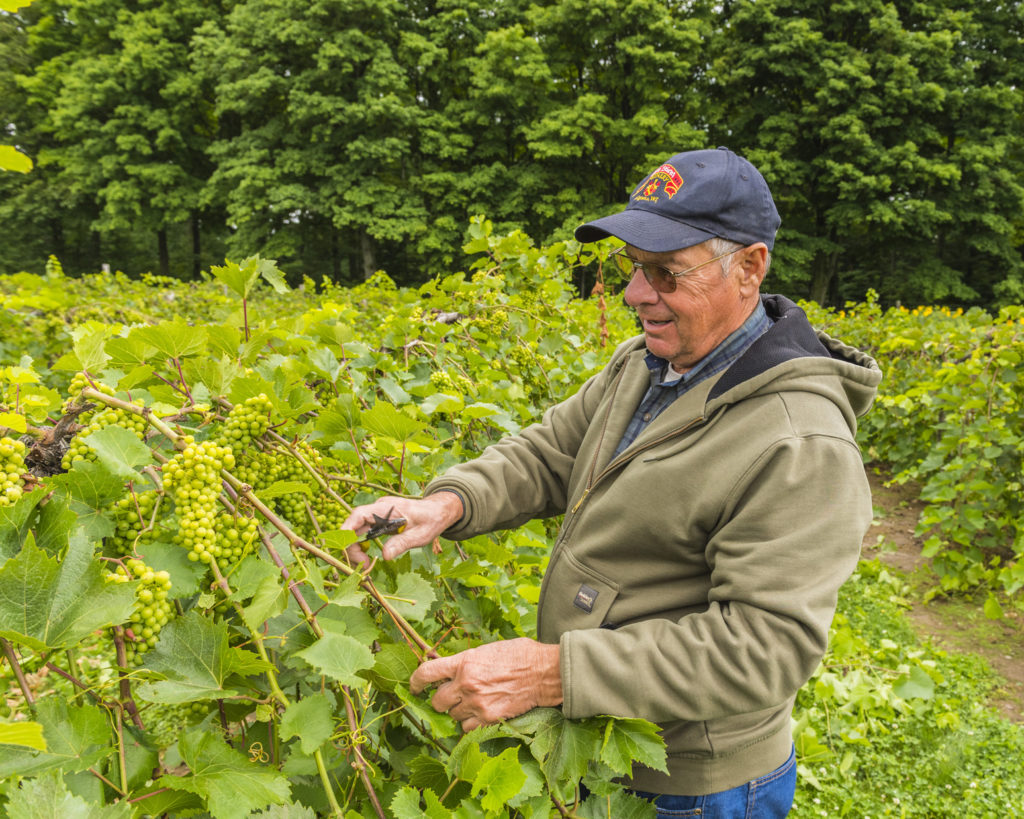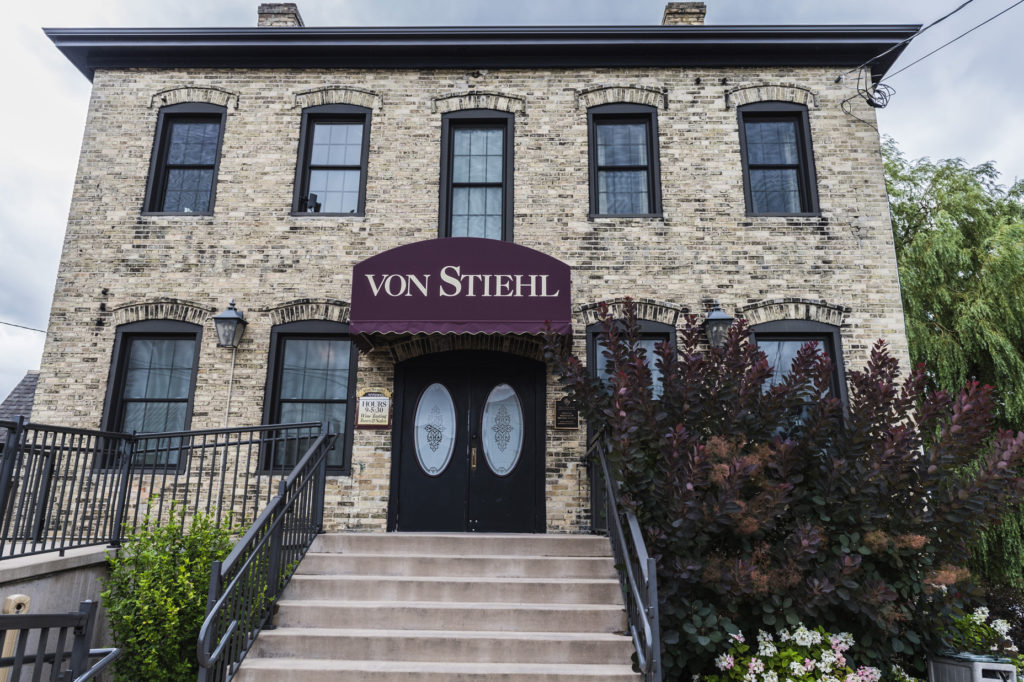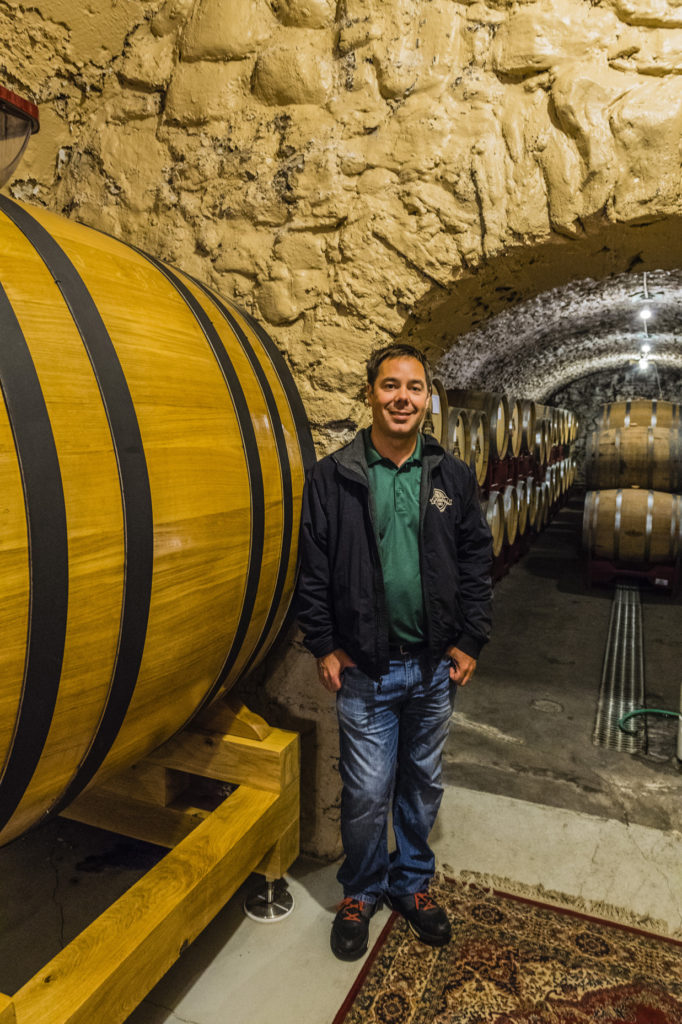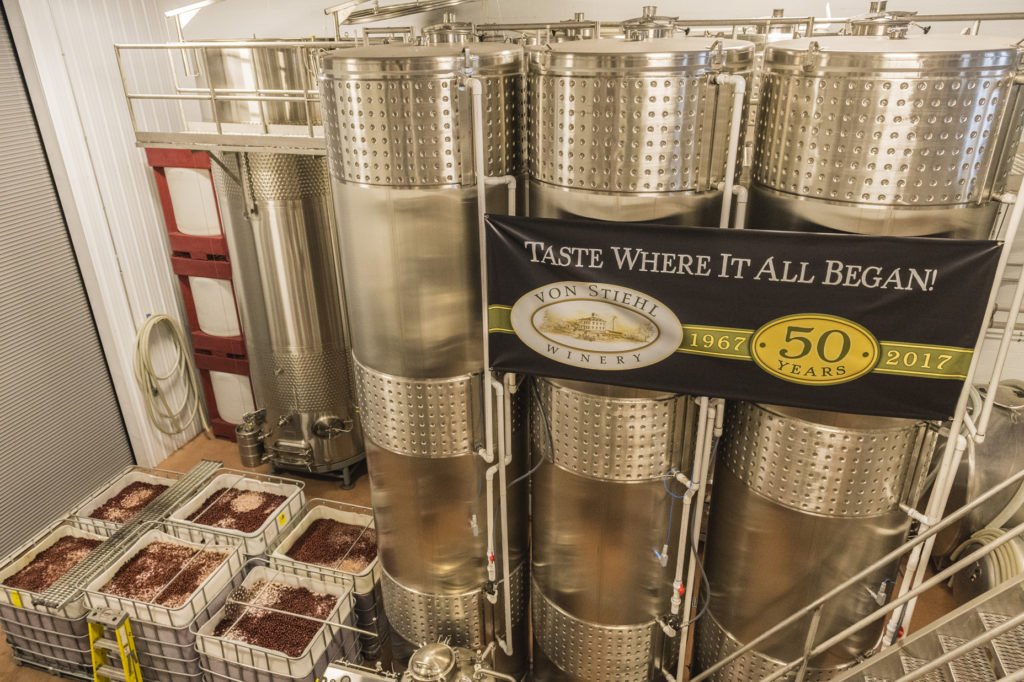A Cherry Wine Fairy Tale: Schmiling Family Shepherds State’s First Winery into 21st Century
- Share
- Tweet
- Pin
- Share

“Once upon a time there was a doctor named Charles Stiehl.”
Those are the opening words Brad Schmiling chose when asked to relate the 50-year history of von Stiehl Winery.
And that is fitting because, at least from the outside, this does seem to be a fairy tale.
The good Dr. Stiehl helped to draft the state’s first winery rules in the 1960s so he could open a cherry winery in Door County. Circumstances led him to open the winery in Algoma instead, and then 13 years later selling his beloved winery to an earnest young man who was just looking for a way to raise his family, and that man’s sons now taking the business into the once-undreamed-of territory as a 21st century Wisconsin winery to be reckoned with.
Bill Schmiling grew up on a dairy farm that his grandfather started in the Algoma area in 1903, home today to Bill’s Stony Creek Vineyard, where he grows Foch grapes for a port his son Aric makes and cold-variety Marquette grapes for a rosé.

Bill Schmiling at his Stony Creek Vineyard.
Bill left the family farm to attend the University of Wisconsin, where he earned a master’s degree in dairy science. He spent seven years in research at the university and was working as herdsman for a large farm in Lake Mills, where his research in dairy cattle breeding was welcome. When the farm consolidated herds it didn’t need two herdsmen.
Schmiling learned that a liquid manure handling equipment manufacturer in Algoma was growing and hiring, so he moved his family back to the area where he had grown up. Then the economic slump of the 1970s set in.
“Times got pretty tough. Interest rates went way up,” Schmiling said. “Farmers were cutting back because loans were going for 18 percent.”
After seven years with the manufacturer, “I could see in the cards they would be selling out and moving from Algoma.”
Brad has a similar, but different, take on why his dad left a regular paycheck to run a winery: “After training his third boss, he could kind of see the writing on the wall and decided this wasn’t a place to stick around.”
But most importantly, Bill did not want to move his family. “We had our roots in the ground here,” he said.
That’s when he got word that von Stiehl Winery was for sale.
“It was the fall of 1980 when we became aware the business was for sale,” Bill said. “At that time Dr. Stiehl owned and operated it just six months out of the year, from May through October.”
At one point, Stiehl was operating three wineries — in Algoma, Baraboo and Rhinelander — but by 1980 he was down to just Algoma.
“That was kind of his baby. He really wanted to keep it operating if he could,” Bill said.
He must have seen the future of von Stiehl Winery in the face of Bill Schmiling, who to this day is surprised how it all happened.
“Here we are buying a business and we had to borrow the down payment,” he said. “Dr. Stiehl was willing to give us a land contract on the rest of it or it never would have worked. He bent over backwards so we could restart that business. And I guess we didn’t have enough sense to know any different. I can’t say I had a real passion to be a winemaker. I was looking at it more as a business venture, a way to feed my family. That’s the truth of the matter.”
“When Bill wanted to leave a good-paying job to be his own boss as a business owner, I made him promise me one thing — that I would not be asked to forsake my own career,” said Bill’s wife, Sandy, who was an ICU RN at Door County Medical Center. “Even though he worked day and night and lost 25 pounds that first year as a winemaker, he upheld his promise. I certainly helped him in many aspects of the winery business over the years but we’ve now celebrated 48 years of marriage and are still going strong.”
And, so, it adds to the fairy-tale nature of this story.
Brad recalls the day the family took possession of the winery. He was 6 and Aric was 7.
“We still have a picture of us standing together in front of the sign,” he said. “As a kid that young you don’t remember too many things, but I do remember that day. I was wearing a Planet of the Apes shirt. That’s when the Schmilings took over. I have very few memories of anything before that. I always say Algoma was our daycare. We would just run around the winery all day. That was our growing up. Dad had us working. Both my father and mother grew up on small dairy farms in the area, and kids worked. So they figured that was a good way to do it and put us to work at whatever they could find so we wouldn’t run around upstairs and make noise.”
“Dr. Stiehl worked with us the first couple of years and taught us,” Bill said. “Cherry and apple wine is all he was making. We continued with that in the beginning, so there wasn’t a whole lot to learn.”
The baroque “three-tier system” didn’t have a stranglehold on the industry back then.
“We sold to the local outlets direct at that time because there were no laws that you couldn’t do that,” Bill said. “Summer business was probably 80 percent of our business. Ray’s Cherry Hut in Fish Creek, he had roots in Algoma and he was always very loyal to us. He was our biggest retailer at the time. And Koepsel’s. The old ones that were in business back in the early ’80s, we dealt with all of them and were on a first-name basis. That helped our business. Immensely.”
Things were sailing smoothly for the young winery.
“We never missed a payment to Dr. Stiehl,” Bill said. “He also helped us with buying ingredients. It’s kind of a seasonal thing. We’d have to buy all our cherries at one time and wouldn’t use them until nine months later. He was pretty much our bank. Him along with Community State Bank. If we needed a three-month loan, you’d walk in and say, this is how much I need and this is when I can pay it back. OK. Come back tomorrow and we’ll have a check for you. It was a whole different world back then. Things were done with a handshake.”
Dr. Stiehl had been selling about 5,000 bottles of his fruit wine annually, and the Schmilings based their first year in business — 1981 — on 1980 sales.
“We were up drastically, just because we were there,” Bill said. Other than that, they didn’t change much in the beginning.
While Stiehl gave Schmiling a good deal in terms of buying the business, there was still the question of the name of the winery.
 “He always said to us, ‘I’m going to let you use the name for a while, but I’m going to see how you do,’” Bill said. “I think it was about three years after we bought it, he called me one day and said ‘It’s time we do something on this name.’ He had patents on his white bottle and trademarks on the name. He said, ‘I’m going to sell you my name now, and I want $1 for it.’ So he was happy with the direction. It was a lot of really good things coming together.”
“He always said to us, ‘I’m going to let you use the name for a while, but I’m going to see how you do,’” Bill said. “I think it was about three years after we bought it, he called me one day and said ‘It’s time we do something on this name.’ He had patents on his white bottle and trademarks on the name. He said, ‘I’m going to sell you my name now, and I want $1 for it.’ So he was happy with the direction. It was a lot of really good things coming together.”
Bill continued. “I think it was after we were in the winery two years, we started branching out and felt pretty confident in what we were doing. We learned a lot from other wineries, basically.”
He quickly adds there weren’t many wineries in the state 35 years ago. But he did get to know the Lawlor family, who owned a winery on the other side of the state in La Crosse.
“Their daughter, Christine, went to University of California — Davis to learn how to make wine. She was one of the smart people in the Midwest who knew how to make wine,” Bill said. “She took me under her wing and really helped, especially when I wanted to branch out to make other kinds of wine. She was very helpful for sources of buying grape juice.”
When he first started making grape wines, Bill said it was all whites.
“We’d split a load of white grape juice with Christine’s winery. She would tell me exactly what I had to do with it to make wine, basically,” he said.
One of the first red grape wines Bill made has become the winery’s biggest seller — Crimson Royale made with Concord grapes.
“We were able to buy Concord grape juice from Spurgeon Vineyards, down south of Dodgeville. Glen Spurgeon had about six acres of Concord grape vines at the time. Concord’s got that really grapey fresh taste to it. It’s just a popular taste. I guess it goes back to my folks, who always had Mogen David. The jug came out when the company came over. That probably had a little bit to do with it.”

Brad Schmiling
Bill says oldest son Aric always had an interest in the winery, but younger brother Brad has a different take.
“Truthfully, when we were both out of high school, neither one of us wanted to come back to the business,” Brad said. “We were done. But we never saw that there could be a fun or interesting side to it. We just did all the grunt work, bottling and cleaning tanks, whatever you could toss kids into doing.”
But, Brad adds, “It wasn’t long after going to college that my brother decided he wanted to come back and get into the wine industry.”
Bill said it was sending Aric to Michigan State to learn winemaking that turned the business around.
“He wasn’t a part of the team yet, but he was interested in pursuing the career,” Bill said. “We sent him to Michigan State to learn winemaking and he learned under a couple of winemakers there. That was really the start of making quality grape wines. Before that we made a late harvest riesling. We had branched out into quite a few fruit wines because they’re basically the same process — cranberry, raspberry, pear. We had about eight kinds of fruit wines at the time. But now grape wines are the main focus of the business.”
Brad points out that Aric returned to the family business in 1997.
“As of this year he’s been back 20 years,” he said.
Brad definitely was not going to return to Algoma.
“I ended up in theater, technical theater, and sort of wrote my own major,” he said. “It was geared toward engineering theater specs and designing them.”
He got an industry dream job, traveling the country with a lighting company.
“But I realized that you either get to pick your family or your dream job. You usually don’t get to pick both,” he said. “So I decided traveling and being alone wasn’t for me.”
He returned to Algoma, thinking it would be a temporary delay in his real life.
Knowing his youngest son had an interest in photography and graphic design, Bill thought of a way for Brad to use those skills to the benefit of the winery.
“I said, ‘Brad, we need a new brochure. Why don’t you see what you can come up with?’” Bill said.
Bill saw the potential for his sons with their different interests working together for the winery.
“Up to that point, I was wearing all the hats,” Bill said. “By dividing their responsibilities, it gave them time to do things better, which is one of the reasons why they are doing so well.”
“I thought I was staying for six months,” Brad said, “but just started working into the more interesting aspects of the business that I had never seen before — sales, marketing and advertising — things I had a bit of an interest in but didn’t realize I could do.”
To this day, Brad has difficulty explaining how he came to return to the family business, but as in the best fairy tales, love is involved.
“All I could do to put an explanation to it, when you find the love of your life, it doesn’t take you long to realize it. You just kind of know,” he said.
Brad and Aric worked alongside their parents for a couple of years before buying the winery from them in 2003.
“It has changed pretty significantly,” Brad said. “Aric’s thing was more traditional grape wines. Von Stiehl had always been known for sweeter cherry wines and apple wines and local fruit, and of course, back then, ‘buy local’ wasn’t a thing, especially when it came to wine.”
Brad said it took a while to develop a base for grape wines.
“We were still kind of fighting the reputation of the sweet wine place. We still do plenty of sweet wine, but we now have a nice dry red following, too,” he said.
Bill is justly proud of his sons and where they have taken the business.
“We started out making our wine in used cheese vats with plastic on top. Back in 1981 we basically put cherry juice in a tank, added some sugar and yeast and hoped it turns out,” Bill said. “Now they pretty much have the latest and greatest in wine technology. Aric is so particular in how he does things. First class. They’ve taken it to a whole new level and it’s showing in their wines.
 “They had a lot of good things happen,” Bill continued. “They bought the building in Green Bay and started Captain’s Walk Winery. That helped them grow. They did a lot more marketing. In 2001 Brad started the Wet Whistle Fest. All these events helped grow the business. It gave them a much wider customer base, and our customers are really loyal. It just amazes me sometimes. Our customers have become our friends, which is a great thing, you know.”
“They had a lot of good things happen,” Bill continued. “They bought the building in Green Bay and started Captain’s Walk Winery. That helped them grow. They did a lot more marketing. In 2001 Brad started the Wet Whistle Fest. All these events helped grow the business. It gave them a much wider customer base, and our customers are really loyal. It just amazes me sometimes. Our customers have become our friends, which is a great thing, you know.”
You have to wonder what the late Dr. Stiehl would make of his winery today.
“I think Dr. Stiehl would be surprised how the industry has taken off,” Bill said.
Of course you know there is only one way this story can end: And they all lived happily ever after.
•••
Sevastopol Missed Chance for Winery
Fifty-two years ago, the Sevastopol Town Board and residents who lived within a quarter-mile of the old Cherry School on the corner of County BB and HH voted against a proposal by Dr. Charles Stiehl to buy the school in order to transform it into the first commercial winery in Wisconsin.
Stiehl, who had a home on Point Beach in the Village of Egg Harbor, was offering $15,000 for the building. He told the assembly that he would use the building to make cherry wine. Cherry juice would be trucked in to be converted into wine, he said, according to a newspaper report of the time. The newspaper report said the purchase price offered was about equal to the debt on the school.
Before Stiehl’s offer, the school had been put up for sale by bid, resulting in a high bid of $2,500, at which point the school was turned over to a real estate agent.
Only one person — Harold Rusche, a cherry grower — voted in favor of Stiehl’s proposal.
So the good doctor took his business south to Algoma, where he bought the former Schmiling Brewery near the mouth of the Ahnapee River and opened von Stiehl Winery in 1967.
Now, the von Stiehl Winery has become a major draw for visitors to Kewaunee County, while the old Cherry School on the outskirts of Sturgeon Bay sits empty, with a for sale sign out front.




